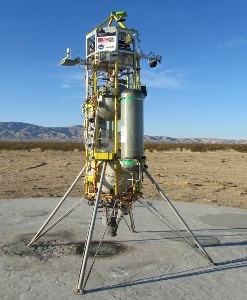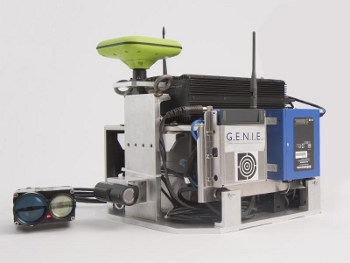 |
| February 28, 2012 | Volume 08 Issue 08 |
Designfax weekly eMagazine
Archives
Partners
Manufacturing Center
Product Spotlight
Modern Applications News
Metalworking Ideas For
Today's Job Shops
Tooling and Production
Strategies for large
metalworking plants
NASA News:
Rocket-powered landing demonstrator makes successful first flight

GENIE and Xombie on the pad: Masten Space Systems' Xombie rocket with Draper Laboratory's GENIE flight control system rests on its launch pad at the Mojave Air and Space Port. [Photo by Draper Lab]
The first successful free flight of a new rocket-powered vertical landing demonstrator occurred recently at Mojave Air and Space Port, Mojave, CA. The flight used a new flight control system concept that will enable future demonstrations of landing technologies needed for exploration of planets and moons, as well as near-Earth objects, like asteroids. NASA's Flight Opportunities Program sponsored the flight and control system test.
Masten Space Systems' Xombie suborbital rocket lifted off the launch pad Feb. 2 while being controlled by Draper Laboratory's Guidance Embedded Navigator Integration Environment (GENIE) system. The rocket rose 164 ft, moved laterally 164 ft, and then landed on another pad after a 67-sec flight. The flight represents the first step in developing a test-bed capability that will allow for landing demonstrations that start at much higher altitudes – several miles above the ground.
With a growing interest in vertical takeoff and landing with commercial suborbital launch vehicles, the Flight Opportunities Program initiated the development of a commercial landing technology demonstration test bed. Draper Laboratory, of Cambridge, MA, was selected to lead this effort. Draper Lab subsequently selected Masten Space Systems to provide the vertical takeoff and landing flight vehicle to demonstrate this new landing technology.

NASA Dryden engaged Draper Laboratory to develop the GENIE flight control system to guide the flight of Masten Space Systems Xombie technology demonstrator. [Photo by Draper Lab]
"The Draper and Masten team has done a tremendous job pulling together this flight demonstration in a short amount of time," says John Kelly, Flight Opportunities Program manager at NASA Dryden. "Draper was awarded this task in September 2011. This capability will allow the program to quickly demonstrate landing technologies for future space missions."
The Flight Opportunities Program, part of NASA's Space Technology Program, is enabling demonstration and maturation of new technology payloads using suborbital reusable launch vehicles, high-altitude balloons, and parabolic aircraft to expose technology payloads to space-relevant environments of reduced gravity or near-space flights.
The program facilitates low-cost access to suborbital environments for a broad range of innovators as a means of advancing space technology development and supporting the evolving entrepreneurial commercial space industry. Among NASA's key goals for the program is regular, frequent, and predictable access to near-space at a reasonable cost with easy recovery of intact payloads.
For more on Masten Space Systems, click here
For more on Draper Laboratory, click here
For more about NASA's Flight Opportunities Program, click here
Source: NASA
Published February 2012
Rate this article
View our terms of use and privacy policy
